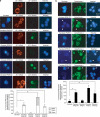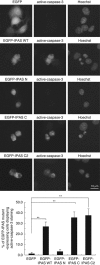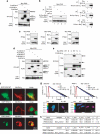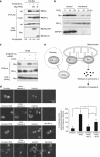Pro-apoptotic activity of inhibitory PAS domain protein (IPAS), a negative regulator of HIF-1, through binding to pro-survival Bcl-2 family proteins
- PMID: 21546903
- PMCID: PMC3190112
- DOI: 10.1038/cdd.2011.47
Pro-apoptotic activity of inhibitory PAS domain protein (IPAS), a negative regulator of HIF-1, through binding to pro-survival Bcl-2 family proteins
Abstract
Inhibitory PAS (Per/Arnt/Sim) domain protein (IPAS) is a dominant negative transcription factor that represses hypoxia-inducible factor 1 (HIF-1) activity. In this study, we show that IPAS also functions as a pro-apoptotic protein through binding to pro-survival Bcl-2 family members. In a previous paper, we reported that NF-κB-dependent IPAS induction by cobalt chloride repressed the hypoxic response in PC12 cells. We found that prolonged incubation under the same conditions caused apoptosis in PC12 cells. Repression of IPAS induction protected cells from apoptosis. Furthermore, knockdown of IPAS recovered cell viability. EGFP-IPAS protein was localized in both the nucleus and the cytoplasm, with a large fraction associated with mitochondria. Mitochondrial IPAS induced mitochondria depolarization and caspase-3 activation. Immunoprecipitation assays revealed that IPAS is associated with Bcl-x(L), Bcl-w and Mcl-1. The association of IPAS with Bcl-x(L) was also observed in living cells by the FLIM-based FRET analysis, indicating direct binding between the two proteins. IPAS contributed to dysfunction of Bcl-x(L) by inhibiting the interaction of Bcl-x(L) with Bax. These results demonstrate that IPAS functions as a dual function protein involved in transcription repression and apoptosis.
Figures










Similar articles
-
Conformational changes in inhibitory PAS domain protein associated with binding of HIF-1α and Bcl-xL in living cells.J Biochem. 2017 Mar 1;161(3):291-296. doi: 10.1093/jb/mvw068. J Biochem. 2017. PMID: 28003430
-
Increase in proapoptotic activity of inhibitory PAS domain protein via phosphorylation by MK2.FEBS J. 2017 Dec;284(23):4115-4127. doi: 10.1111/febs.14300. Epub 2017 Nov 13. FEBS J. 2017. PMID: 29054108
-
Transcriptional up-regulation of inhibitory PAS domain protein gene expression by hypoxia-inducible factor 1 (HIF-1): a negative feedback regulatory circuit in HIF-1-mediated signaling in hypoxic cells.J Biol Chem. 2007 May 11;282(19):14073-82. doi: 10.1074/jbc.M700732200. Epub 2007 Mar 12. J Biol Chem. 2007. PMID: 17355974
-
The BH3 alpha-helical mimic BH3-M6 disrupts Bcl-X(L), Bcl-2, and MCL-1 protein-protein interactions with Bax, Bak, Bad, or Bim and induces apoptosis in a Bax- and Bim-dependent manner.J Biol Chem. 2011 Mar 18;286(11):9382-92. doi: 10.1074/jbc.M110.203638. Epub 2010 Dec 9. J Biol Chem. 2011. PMID: 21148306 Free PMC article.
-
Binding and regulation of hypoxia-inducible factor-1 by the inhibitory PAS proteins.Biochem Biophys Res Commun. 2005 Nov 11;337(1):209-15. doi: 10.1016/j.bbrc.2005.09.038. Biochem Biophys Res Commun. 2005. PMID: 16182248
Cited by
-
Imbalanced oxidative stress causes chlamydial persistence during non-productive human herpes virus co-infection.PLoS One. 2012;7(10):e47427. doi: 10.1371/journal.pone.0047427. Epub 2012 Oct 15. PLoS One. 2012. PMID: 23077614 Free PMC article.
-
Nuclear-cytoplasmatic shuttling of proteins in control of cellular oxygen sensing.J Mol Med (Berl). 2015 Jun;93(6):599-608. doi: 10.1007/s00109-015-1276-0. Epub 2015 Mar 27. J Mol Med (Berl). 2015. PMID: 25809665 Review.
-
The "Sharp" blade against HIF-mediated metastasis.Cell Cycle. 2012 Dec 15;11(24):4530-5. doi: 10.4161/cc.22820. Epub 2012 Nov 27. Cell Cycle. 2012. PMID: 23187809 Free PMC article.
-
Hydrogen sulfide is expressed in the human and the rat cultured nucleus pulposus cells and suppresses apoptosis induced by hypoxia.PLoS One. 2018 Feb 21;13(2):e0192556. doi: 10.1371/journal.pone.0192556. eCollection 2018. PLoS One. 2018. PMID: 29466396 Free PMC article.
-
Vascular endothelial growth factor signaling in hypoxia and inflammation.J Neuroimmune Pharmacol. 2014 Mar;9(2):142-60. doi: 10.1007/s11481-014-9531-7. Epub 2014 Mar 9. J Neuroimmune Pharmacol. 2014. PMID: 24610033 Free PMC article. Review.
References
-
- Hirota K, Semenza GL. Regulation of hypoxia-inducible factor 1 by prolyl and asparaginyl hydroxylases. Biochem Biophys Res Commun. 2005;338:610–616. - PubMed
-
- Kaelin WG., Jr The von Hippel-Lindau protein, HIF hydroxylation, and oxygen sensing. Biochem Biophys Res Commun. 2005;338:627–638. - PubMed
-
- Schofield CJ, Ratcliffe PJ. Signalling hypoxia by HIF hydroxylases. Biochem Biophys Res Commun. 2005;338:617–626. - PubMed
-
- Makino Y, Cao R, Svensson K, Bertilsson G, Asman M, Tanaka H, et al. Inhibitory PAS domain protein is a negative regulator of hypoxia-inducible gene expression. Nature. 2001;414:550–554. - PubMed
-
- Makino Y, Uenishi R, Okamoto K, Isoe T, Hosono O, Tanaka H, et al. Transcriptional up-regulation of inhibitory PAS domain protein gene expression by hypoxia-inducible factor 1 (HIF-1): a negative feedback regulatory circuit in HIF-1-mediated signaling in hypoxic cells. J Biol Chem. 2007;282:14073–14082. - PubMed
MeSH terms
Substances
LinkOut - more resources
Full Text Sources
Molecular Biology Databases
Research Materials

